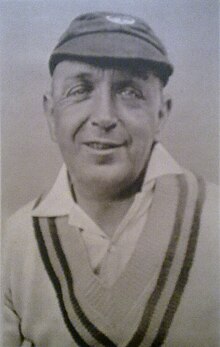Fred Root
 |
||||||||||||||||||||||||||||||||||||||||
| Personal information | ||||||||||||||||||||||||||||||||||||||||
|---|---|---|---|---|---|---|---|---|---|---|---|---|---|---|---|---|---|---|---|---|---|---|---|---|---|---|---|---|---|---|---|---|---|---|---|---|---|---|---|---|
| Full name | Charles Frederick Root | |||||||||||||||||||||||||||||||||||||||
| Born |
16 April 1890 Somercotes, Derbyshire, England |
|||||||||||||||||||||||||||||||||||||||
| Died | 20 January 1954 (aged 63) Wolverhampton, England |
|||||||||||||||||||||||||||||||||||||||
| Batting style | Right-handed batsman (RHB) | |||||||||||||||||||||||||||||||||||||||
| Bowling style | Right-arm fast medium (RFM) | |||||||||||||||||||||||||||||||||||||||
| International information | ||||||||||||||||||||||||||||||||||||||||
| National side | ||||||||||||||||||||||||||||||||||||||||
| Test debut | 12 June 1926 v Australia | |||||||||||||||||||||||||||||||||||||||
| Last Test | 24 July 1926 v Australia | |||||||||||||||||||||||||||||||||||||||
| Domestic team information | ||||||||||||||||||||||||||||||||||||||||
| Years | Team | |||||||||||||||||||||||||||||||||||||||
| 1910–1920 | Derbyshire | |||||||||||||||||||||||||||||||||||||||
| 1921–1932 | Worcestershire | |||||||||||||||||||||||||||||||||||||||
| Career statistics | ||||||||||||||||||||||||||||||||||||||||
|
||||||||||||||||||||||||||||||||||||||||
|
Source: [1], 11 July 2010
|
||||||||||||||||||||||||||||||||||||||||
Charles Frederick (Fred) Root (16 April 1890 – 20 January 1954) was an English cricketer who played for England in 1926 and for Derbyshire between 1910 and 1920 and for Worcestershire between 1921 and 1932.
Root was born in Somercotes, Derbyshire and initially served on ground staff of Leicestershire before beginning his first-class career for Derbyshire, making his debut in the 1910 season. He played for five seasons for Derbyshire before cricket was suspended in England because of World War I, doing very little apart from a couple of promising performances in 1913. During the war, Root was hit in the chest while serving as a dispatch rider, but recovered and resumed his cricketing career after the war.
Root moved to Worcestershire in 1921 after two seasons in league cricket. After a season and a half when he failed to establish himself as an orthodox right-arm fast medium bowler (RFM), Root became an exponent of the leg theory style of bowling, and achieved great success with it. His ability to swing the ball in and make it gain pace off the ground made him very difficult on anything like a fiery pitch, whilst his powerful physique and consequent stamina made Root respected even on pitches giving bowlers no assistance. In 1923 he took 170 wickets for 20.53 each and 153 for less than 17 each in 1924, but spoilt his chances of going on that winter's Ashes tour with a poor performance for the Players at the Oval on a pitch that should have suited him.
Although Worcestershire were entering a period where they were the weakest of the County teams, Root's tireless, accurate and lively bowling only improved. In 1925 he took a record 207 wickets for the county, almost half of Worcestershire's wickets in first class matches. During the late 1920s, Root was effectively the team's only penetrative bowler. In 1926 Root took 7 for 42 against the Australians on a pitch so dead as to be quite unsuited to him. Though he was less effective than previously in county cricket (soft pitches may have played a part), Root played three Test matches for England against Australia that year. Unusually he was unable to bat in any of the three tests, due to rain interruptions and the depth of the England batting. Root still holds the record for the most Test Matches in a career without ever batting.
...
Wikipedia
